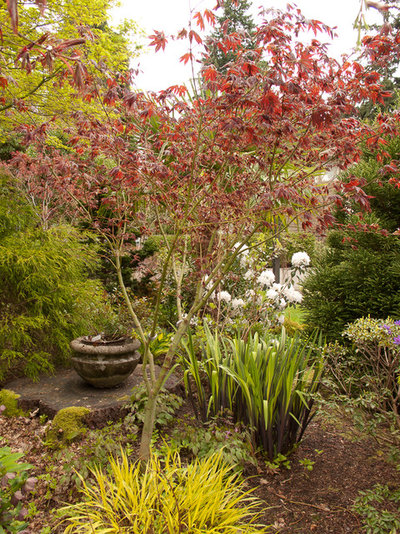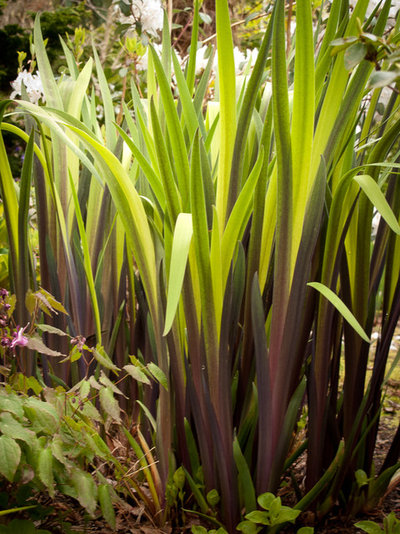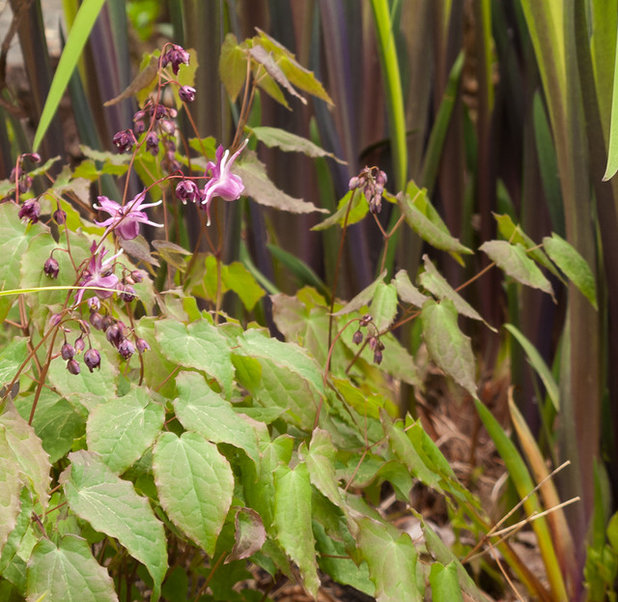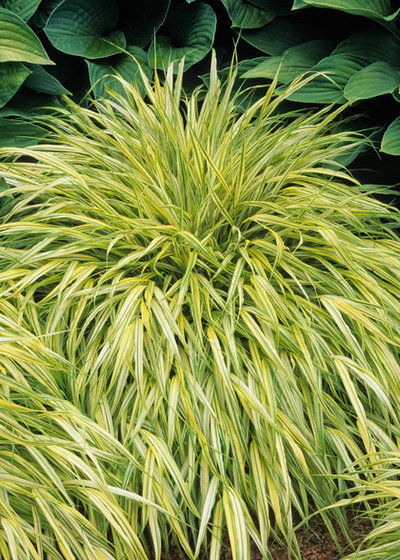When we think of spring, we immediately picture cherry blossoms, daffodils and primroses, yet there are more ways to celebrate the rebirth of the garden. Take advantage of the dappled light and increased visibility under deciduous trees by combining plants that have exciting, seasonal features that will fade as the canopy overhead grows deeper.

Le jardinet
Focus on Seasonal DetailsAs always, attention to detail is key when creating plant combinations, and here it is all about timing. This bishop’s hat is blooming while the purple variegation on the iris is evident; the bishop’s hat echoes the iris’ ephemeral color with a softer shade of lavender. By the time the iris fades, the bishop’s hat too will have finished its bloom cycle.
Without the splash of bright yellow Japanese forest grass, these two plants might have faded into a muddle of midgreen. Yet this waterfall of subtle gold and green variegated blades throws light under the canopy of the tree, adds a new leaf texture and will be eye catching until early winter.

Le jardinet
This iris stopped me in my tracks. I was so excited by the gorgeous smoky purple color at the base of each blade that I immediately reached for my camera and lay on the ground to take a closer look — such is the life of a foliage-aholic. I was so glad that I did, as this striking color fades to green in summer after the iris has finished blooming. Personally I wouldn’t mind it if
never flowered; I would grow it for the foliage alone.
Here’s how to get the look of this plant combination.

Le jardinet
1. Begin with the star.Gerald Darby Siberian Iris(
Iris x
robusta ‘Gerald Darby’)
In early spring bold fans emerge, each blade a rich plum at the base, fading to green toward the tips. In May black stalks rise high to produce a profusion of buds that open to small violet flowers splashed with yellow.
As the flowers fade, so does the unique foliage color, although the fat green seedpods continue to add interest.
This easy-care iris loves moist conditions and can even be grown in 2 to 4 inches of standing water, making it a possible alternative to flag irises, which are invasive in many states. It is equally attractive planted in groups in a garden setting, where drip irrigation could be used to meet its water requirements.
Origin: Garden hybrid
Where it will grow: Hardy to -30 degrees Fahrenheit (USDA zones 4 to 9; find your zone)
Water requirement: Average to wet soil
Light requirement: Dappled shade to full sun
Mature size: To
3 feet high and 2 feet wide
Benefits and tolerances: Deer resistant
When to plant: Spring or fall

Le jardinet
2. Add a supporting player.Lilafee Bishop’s Hat(
Epimedium grandiflorum ‘Lilafee’)
This perennial is a workhorse in the shade garden, coping with less-than-favorable conditions yet slowly producing clumps of attractive foliage and spring blooms. Lavender flowers are held high on wiry stems above the new green leaves, which are edged in red in spring. Unlike many bishop’s hats, this variety is herbaceous, turning red in fall before dying down in the winter.
This easy-care perennial is ideal for woodland settings, where it will form a dense ground cover under trees — often a challenging location.
Origin: Japan
Where it will grow: Hardy to -25 degrees Fahrenheit (zones 5 to 8)
Water requirement: Average to dry soil
Light requirement: Dappled shade to full shade
Mature size: 18 inches tall and wide
Benefits and tolerances: Deer resistant; drought tolerant once established
When to plant: Spring or fall

Monrovia
3. Accent the duo and extend the season of interest.Japanese Forest Grass(
Halonechloa macra ‘Aureola’)
A favorite of gardeners since its introduction, herbaceous Japanese forest grass never fails to please. Green and yellow variegated blades emerge in tufts in early spring, quickly growing into a mounding waterfall of delicate foliage that is perfect for border edges or cascading over boulders.
Although it’s recommended as a grass for the shade garden, I have been equally successful with it in sunnier locations, providing it is well watered.
In fall it is tinged with shades of red before it dies down for the winter.
Origin: Japan
Where it will grow: Hardy to -30 degrees Fahrenheit (zones 4 to 9)
Water requirement: Average, moisture-retentive soil
Light requirement: Partial
shade to full sun (if well watered); it will be more green in shade and soft yellow in sun
Mature size: 2 feet tall and 3 feet wide
Benefits and tolerances: Deer resistant
When to plant: Spring or fall
More ideas for spring gardening





